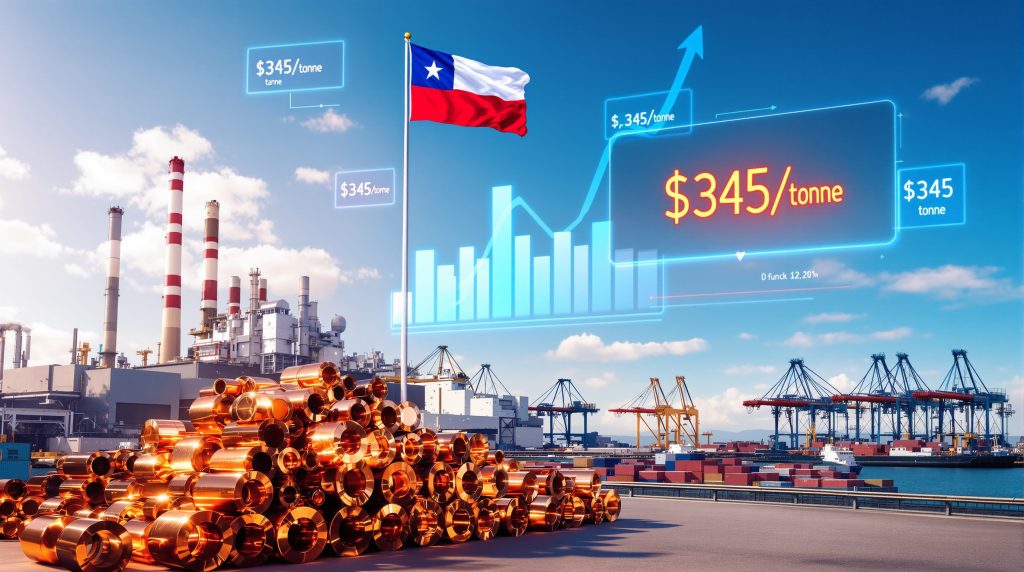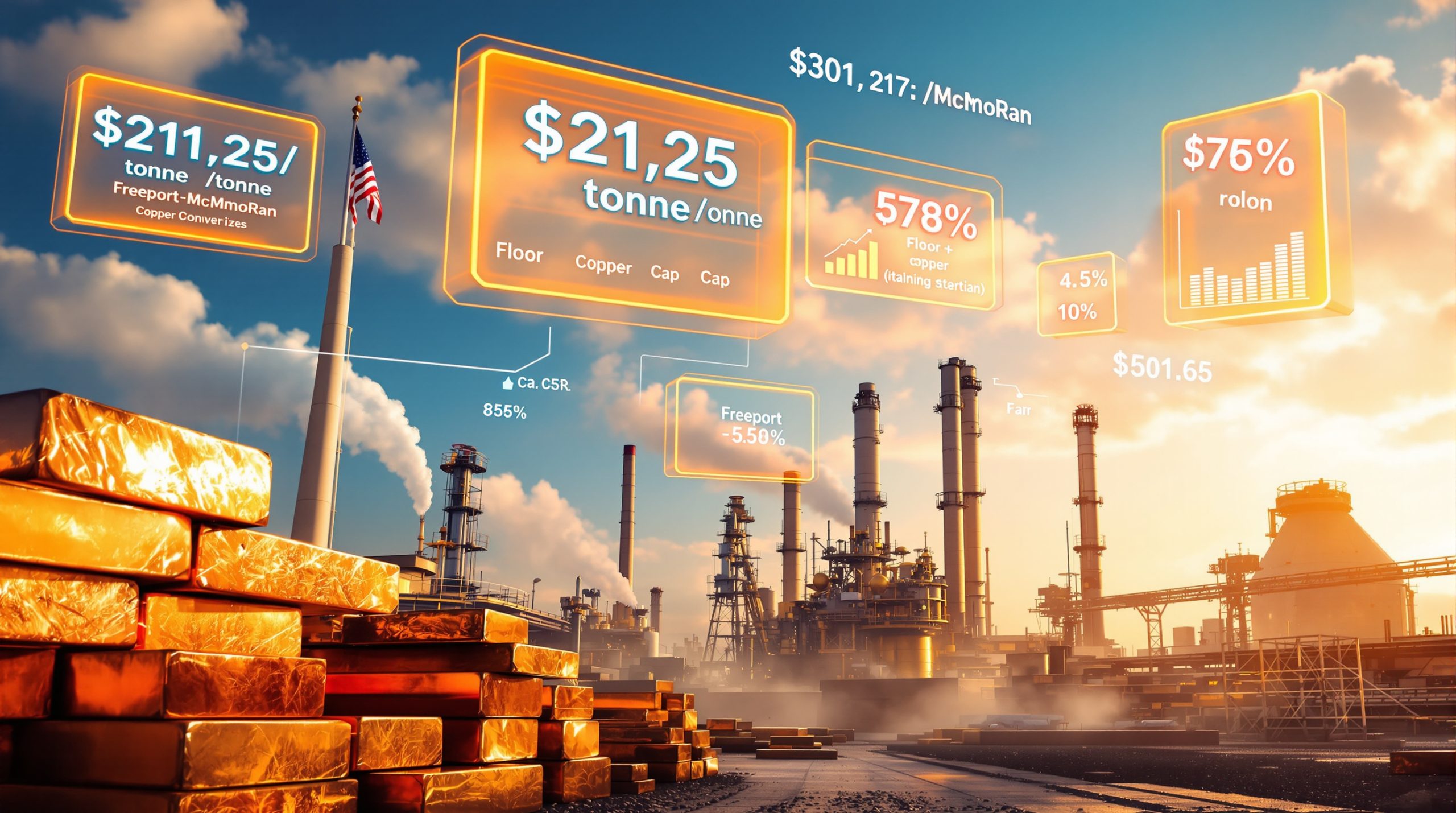Copper premiums represent a critical component of global metal trading that extends beyond the basic London Metal Exchange benchmark pricing. These additional fees, paid on top of LME contract prices, reflect the real-world costs and market dynamics of physical copper delivery to specific regions.
When Codelco hikes European copper premium rates, the ripple effects extend throughout the global supply chain. As the world's largest copper producer, Chile's state-owned mining giant serves as a benchmark setter for international contracts across power and construction industries. The premium structure accounts for transportation logistics, regional supply-demand imbalances, and delivery specifications that LME futures contracts cannot capture. Furthermore, copper price prediction models must incorporate these premium adjustments to provide accurate forecasting for industrial buyers.
The significance of these premiums becomes apparent when considering their proportion to base metal prices. With LME copper trading around $10,600 per tonne as of October 2025, a $345 premium represents approximately 3.3% additional cost for European buyers. This seemingly modest percentage translates into substantial financial impacts across industrial supply chains.
Premium Structure and Market Mechanics
Physical copper cathode delivery requires comprehensive pricing beyond exchange-traded futures. Regional premiums compensate suppliers for:
- Quality certifications and purity specifications
- Transportation and logistics coordination
- Insurance and storage requirements
- Regional market access and distribution networks
- Currency hedging and financial risk management
The benchmark nature of Codelco's pricing decisions stems from the company's massive production capacity and established customer relationships. When the Chilean producer adjusts premium levels, competing suppliers typically follow suit to maintain market competitiveness while reflecting similar cost pressures.
Why Did Codelco Raise European Copper Premiums to Record Levels?
Market analysts attribute the unprecedented 39% premium increase to a convergence of supply-side disruptions and evolving demand patterns. The adjustment from $248 per tonne in 2025 to $345 per tonne for 2026 deliveries reflects fundamental shifts in global copper availability rather than temporary market volatility.
Supply constraints have emerged as the primary driver behind premium increases. Multiple major mining operations experienced significant disruptions throughout 2025, creating anticipated shortages that pushed LME copper prices to 16-month highs near $11,000 per tonne. Market participants recognised these supply challenges would persist into 2026, justifying higher premium levels.
The timing of Codelco's announcement coincides with broader industry recognition of structural supply deficits. European buyers, already facing elevated energy costs and supply chain uncertainties, now confront additional pressure from record copper premiums. Additionally, the global copper supply forecast indicates continued tightness through 2026, supporting these elevated premium levels.
Market Psychology and Pricing Power
Codelco's ability to implement such substantial premium increases demonstrates the company's pricing power during supply-constrained periods. The state-owned producer declined to comment on the pricing decision, but market sources confirm the adjustment reflects legitimate supply-demand fundamentals rather than opportunistic pricing.
European customers have limited alternatives when major suppliers implement coordinated premium increases. The concentration of global copper production among relatively few major producers creates oligopolistic pricing dynamics during shortage periods. Consequently, buyers must accept higher premiums or risk supply security for critical industrial operations.
Supply Chain Disruptions Fuelling Premium Growth
Three major mining disruptions during 2025 created the supply constraints driving record premium levels. Each incident affected different geographical regions and production methods, compounding overall market tightness.
Grasberg Mine Force Majeure
Freeport-McMoRan's declaration of force majeure at Indonesia's Grasberg mine represents the most significant supply disruption. As the world's second-largest copper mine, Grasberg's production halt following mudslide damage removed substantial volumes from global markets. The September 2025 incident highlighted the vulnerability of large-scale mining operations to natural disasters and geological instability.
The force majeure declaration legally protects Freeport-McMoRan from contractual obligations during the operational suspension. However, the timing coincided with already tight copper markets, amplifying price pressures. Recovery timelines remain uncertain, contributing to 2026 supply shortage concerns that justify higher premiums.
African and Chilean Operations
Disruptions at the Democratic Republic of Congo's Kamoa-Kakula mine and Chile's El Teniente operation added complexity to global supply calculations. In addition, the panama mine disruption earlier in the year further strained global supply chains. While specific details regarding the nature and extent of these disruptions remain limited, their combined impact reinforced market concerns about production reliability.
The geographical diversity of these disruptions prevents buyers from easily substituting supplies between regions. African, Indonesian, and South American production challenges simultaneously affect different customer bases and supply chains, creating widespread shortage concerns rather than localised impacts.
Major Copper Mine Disruptions (2025)
| Mine | Location | Ranking | Disruption Type | Status |
|---|---|---|---|---|
| Grasberg | Indonesia | #2 Globally | Mudslide/Force Majeure | September 2025 |
| Kamoa-Kakula | DR Congo | Major African Producer | Operational Issues | 2025 |
| El Teniente | Chile | Codelco-Owned | Production Challenges | 2025 |
European Market Dynamics and Supply Security
European copper demand patterns reflect the region's industrial composition and infrastructure investment priorities. Power generation, construction, and manufacturing sectors drive consistent consumption that cannot easily adjust to price fluctuations. This demand inelasticity provides suppliers with pricing power during shortage periods.
The geopolitical dimension adds complexity to European copper sourcing strategies. Regional buyers increasingly prioritise supply security over cost optimisation, particularly given broader concerns about commodity supply chain resilience. This strategic shift supports higher premium acceptance when reliable suppliers offer long-term availability guarantees.
Regional Industrial Applications
European copper consumption concentrates in several key sectors that demonstrate varying price sensitivity:
- Power Infrastructure: Grid modernisation and renewable energy integration require substantial copper volumes for electrical conductivity applications
- Construction Industry: Building standards and infrastructure projects maintain steady demand regardless of price fluctuations
- Manufacturing Base: Automotive, aerospace, and industrial equipment production relies on copper for components and electrical systems
Each sector faces different constraints when managing higher input costs, but critical applications cannot substitute alternative materials without significant performance compromises or regulatory compliance issues. Moreover, rising copper demand trends indicate these sectors will continue requiring substantial copper volumes despite elevated premiums.
How Do Copper Premiums Compare Across Major Suppliers?
Europe's largest copper smelter, Aurubis, implemented premium increases matching Codelco's 39% adjustment rate. This coordination suggests industry-wide recognition of changed market fundamentals rather than isolated pricing decisions by individual suppliers.
2026 European Copper Premium Comparison
| Supplier | 2026 Premium | 2025 Premium | Increase | Percentage Change |
|---|---|---|---|---|
| Codelco | $345/tonne | $248/tonne | $97/tonne | +39% |
| Aurubis | $315/tonne | $227/tonne | $88/tonne | +39% |
| Industry Average* | $330/tonne | $238/tonne | $92/tonne | +39% |
*Based on available data from major suppliers
The alignment between Codelco and Aurubis premium increases indicates coordinated market response rather than competitive pricing strategies. Both companies face similar input costs, transportation challenges, and supply constraints that justify parallel premium adjustments.
Supplier Differentiation Strategies
While premium levels show remarkable consistency, suppliers differentiate through contract terms and service offerings:
- Delivery flexibility and scheduling accommodation
- Quality specifications exceeding standard requirements
- Financial terms including payment schedules and currency options
- Technical support for specialised applications
- Long-term supply guarantees during volatile periods
These value-added services become increasingly important when base premiums reach record levels, as buyers seek maximum value from unavoidable cost increases.
What Does This Mean for Global Copper Markets?
The record premium increases signal fundamental shifts in global copper market dynamics extending beyond temporary supply disruptions. Market participants must adjust expectations for pricing, availability, and contractual relationships throughout 2026 and potentially beyond.
Short-Term Market Implications
Immediate effects include cost pressure on European manufacturing and construction sectors. Companies with fixed-price customer contracts face margin compression, while those with cost-plus arrangements must negotiate price increases with downstream buyers. The 39% premium increase compounds existing inflationary pressures across industrial supply chains.
Financial market impacts extend to commodity trading strategies and risk management approaches. LME copper prices already reflect supply shortage concerns, but physical market premiums provide additional evidence of market tightness that futures contracts cannot fully capture. Copper investment insights suggest this trend will continue influencing portfolio allocation decisions.
Structural Market Evolution
Long-term implications suggest permanent changes to global copper market structure. The concentration of production among fewer major suppliers increases pricing power during shortage periods. Environmental regulations and permitting challenges limit new mine development, supporting sustained premium levels even after current supply disruptions resolve.
"The coordination between major suppliers on premium increases demonstrates oligopolistic pricing behaviour that could persist as long as supply remains constrained relative to growing demand from electrification and infrastructure investment."
Regional market fragmentation may accelerate as buyers prioritise supply security over cost optimisation. European customers might accept higher premiums from reliable suppliers rather than risk supply interruptions from lower-cost alternatives with uncertain availability.
How Are Other Major Copper Producers Responding?
Freeport-McMoRan's Operational Challenges
The force majeure declaration at Grasberg mine represents Freeport-McMoRan's most significant operational challenge in recent years. While the company maintains other production facilities, Grasberg's massive scale means the disruption cannot be easily compensated through increased output elsewhere.
Recovery efforts focus on geological stabilisation and infrastructure reconstruction following the mudslide damage. However, the technical complexity and safety considerations require extended timelines that contribute to 2026 supply shortage forecasts. The company's inability to provide specific restart dates creates planning difficulties for customers and contributes to premium increases across competing suppliers.
Regional Producer Strategies
African copper producers face pressure to expand output amid global supply constraints. However, infrastructure limitations, regulatory challenges, and financing constraints limit rapid production increases. The Democratic Republic of Congo's political stability concerns also affect long-term investment decisions despite the country's substantial copper reserves.
South American producers beyond Codelco evaluate expansion opportunities as premium levels justify higher development costs. Peruvian mining companies particularly benefit from proximity to Pacific shipping routes and established infrastructure, though environmental regulations and community relations remain challenging factors.
Regional Production Response Capacity
- African Mines: Limited by infrastructure and political risk
- Australian Producers: Constrained by labour costs and distance to markets
- Peruvian Operations: Moderate expansion potential with regulatory hurdles
- North American Facilities: High-cost production economics limit competitiveness
What Should Copper Buyers Expect in 2026?
European copper buyers must prepare for sustained higher costs throughout 2026 as supply constraints persist and premium levels stabilise at elevated rates. The 39% increase represents a permanent adjustment rather than temporary pricing volatility, requiring strategic procurement adaptations.
Contract Negotiation Landscape
Negotiating copper supply contracts for 2026 delivery occurs within a fundamentally different market environment. Suppliers possess enhanced pricing power while buyers face limited alternatives and supply security concerns. This dynamic shifts negotiation leverage significantly toward producers.
Key negotiation considerations include:
- Volume guarantees during supply-constrained periods
- Pricing mechanisms that balance cost predictability with market responsiveness
- Delivery scheduling to optimise logistics and inventory management
- Force majeure terms addressing supply disruption risks
- Quality specifications ensuring consistent material properties
Buyers increasingly prioritise supply reliability over cost optimisation, accepting higher premiums in exchange for guaranteed availability during shortage periods.
Alternative Sourcing Strategies
Secondary copper markets offer potential cost savings, though availability remains limited relative to primary demand. Recycling operations cannot rapidly scale to offset primary supply shortages, but they provide marginal relief for specific applications where recycled content meets technical requirements.
Strategic inventory management becomes critical as suppliers implement allocation systems during tight markets. Companies with adequate storage capacity can optimise purchasing timing to minimise cost impacts, though carrying costs must be balanced against potential future price increases.
How Will This Impact Different Industry Sectors?
Construction and Infrastructure Development
Building and infrastructure projects face immediate cost pressures from higher copper premiums. Electrical systems, plumbing, and HVAC installations require substantial copper volumes that cannot be substituted without performance compromises or regulatory compliance issues.
Project economics must adjust to incorporate sustained higher material costs. Fixed-price construction contracts become increasingly risky as commodity price volatility exceeds typical contingency allowances. Many contractors implement material escalation clauses or require cost-plus arrangements to manage copper price exposure.
Construction Sector Impact Assessment
- Residential Building: 2-4% cost increase for typical electrical and plumbing systems
- Commercial Projects: 3-6% impact on mechanical and electrical systems
- Infrastructure: 4-8% increase for power transmission and distribution components
- Industrial Facilities: 5-10% higher costs for electrical infrastructure and equipment
Power Generation and Distribution
Renewable energy development faces particular challenges as wind turbines and solar installations require substantial copper content for electrical generation and transmission components. Grid modernisation projects also demand extensive copper usage for smart grid technologies and energy storage systems.
Utility companies must balance higher material costs against renewable energy development timelines and regulatory requirements. Some projects may experience delays as operators reassess economics under elevated commodity prices, though government incentives and environmental mandates limit flexibility to postpone critical infrastructure investments.
Manufacturing Sector Adjustments
Automotive manufacturers encounter copper cost increases across multiple applications including wiring harnesses, electric motors, and charging infrastructure for electric vehicles. The transition toward electrification amplifies copper content per vehicle, compounding cost pressures from higher premiums.
Electronics manufacturers face margin pressure as copper content in semiconductors, printed circuit boards, and electrical components represents significant material costs. Companies must balance price increases to customers against competitive positioning in price-sensitive markets.
Investment Implications and Market Opportunities
Copper Mining Stock Performance
Mining company valuations reflect the dual impact of higher commodity prices and improved profit margins from premium increases. Established producers with low-cost operations benefit most from sustained higher pricing, while high-cost marginal producers achieve improved project economics.
Investment themes focus on:
- Major Producers: Enhanced cash flow generation from premium increases and higher base prices
- Development Projects: Improved economics justify previously marginal deposits
- Exploration Companies: Increased value for copper discovery potential
- Technology Providers: Equipment and services supporting production expansion
Commodity Trading Considerations
Physical copper markets demonstrate increasing separation from financial futures pricing as premiums reach record levels. This basis differential creates arbitrage opportunities for traders with storage and logistics capabilities, though physical market access requires substantial infrastructure investment.
Risk management strategies must account for premium volatility alongside base price movements. Traditional hedging approaches focused on LME futures provide incomplete protection against total procurement costs including premiums.
Trading Strategy Framework
- Physical vs. Financial Arbitrage: Exploit premium/futures pricing differentials
- Regional Premium Spreads: Trade premium differences between markets
- Calendar Spreads: Position for premium changes across delivery periods
- Cross-Commodity Relationships: Monitor correlations with other industrial metals
Frequently Asked Questions About Copper Premiums
What Factors Determine Copper Premium Levels?
Copper premiums reflect multiple market variables beyond basic supply-demand fundamentals. Transportation costs from producing regions to consumption centres represent a significant component, particularly for European buyers sourcing from South American and African mines.
Market structure also influences premium determination. The concentration of global copper production among relatively few major suppliers creates pricing power during shortage periods. Quality specifications and delivery terms add complexity, as buyers requiring specific grades or scheduling flexibility pay additional premiums.
Primary Premium Determinants
- Supply-demand regional imbalances
- Transportation and logistics costs
- Quality specifications and delivery terms
- Supplier concentration and pricing power
- Market structure and competitive dynamics
- Geopolitical risk assessments
How Often Do Copper Premiums Change?
Premium adjustments typically follow annual negotiation cycles between major suppliers and large-volume customers. However, significant supply disruptions or demand shifts can trigger mid-cycle adjustments, as demonstrated by the unprecedented increases implemented for 2026 deliveries.
Spot market premiums fluctuate more frequently based on immediate supply availability and logistics constraints. These short-term variations provide early indicators of structural premium changes that eventually affect long-term contract negotiations.
Can Copper Premiums Decrease Rapidly?
Premium reductions require fundamental improvements in supply-demand balance or competitive pressure from alternative suppliers. Historical precedents exist for rapid premium declines when new production capacity comes online or demand weakens due to economic downturns.
However, the current market structure suggests premiums may remain elevated longer than typical cycles. Limited new mine development, extended permitting processes, and growing demand from electrification trends support sustained higher premium levels even after current supply disruptions resolve.
Looking Ahead: Copper Market Outlook Through 2030
Supply Side Development Constraints
New copper mine development faces unprecedented challenges that limit supply growth potential through the remainder of the decade. Environmental regulations, permitting delays, and community relations issues extend development timelines while increasing capital requirements for new projects.
The geological reality of copper deposits also constrains rapid supply expansion. High-grade, easily accessible deposits have been largely developed, leaving lower-grade resources that require more energy-intensive processing and generate higher environmental impacts.
Supply Development Timeline Challenges
- Exploration to Production: 10-15 years for major new discoveries
- Permitting Processes: 3-7 years depending on jurisdiction
- Environmental Assessments: 2-5 years for comprehensive studies
- Infrastructure Development: 2-4 years for remote locations
- Community Relations: Ongoing requirements throughout project lifecycle
Demand Growth Acceleration
Electrification trends across transportation, power generation, and industrial applications drive structural copper demand growth that exceeds historical consumption patterns. Electric vehicles require 3-4 times more copper than internal combustion vehicles, while renewable energy systems demand substantial copper content for electrical components.
Infrastructure modernisation, particularly in developing economies, adds another layer of demand growth. Smart grid technologies, urban development, and industrial automation all require copper-intensive systems that cannot easily substitute alternative materials.
Price Forecasting Considerations
Long-term copper price forecasts must incorporate both supply constraints and accelerating demand from electrification. The intersection of limited supply growth potential with structural demand increases suggests sustained higher pricing throughout the decade.
However, economic cycles, technological developments, and recycling improvements could moderate price increases. Market participants should prepare for continued volatility around an upward trending price trajectory rather than smooth, predictable increases.
Key Takeaways for Market Participants
"Codelco hikes European copper premium to record levels reflecting fundamental market transformation rather than cyclical adjustment, requiring long-term strategic adaptation across industrial supply chains."
The 39% premium increase to $345 per tonne represents a permanent shift in copper market dynamics that market participants must integrate into strategic planning. Supply constraints, geopolitical considerations, and structural demand growth support sustained higher premium levels extending beyond current disruptions.
Essential Strategic Adaptations
- Procurement Strategy: Prioritise supply security over cost optimisation during shortage periods
- Contract Terms: Negotiate volume guarantees and delivery flexibility to manage supply risks
- Inventory Management: Optimise strategic stockpiles to buffer against supply disruptions
- Alternative Materials: Evaluate substitution opportunities where technically feasible
- Financial Planning: Incorporate sustained higher copper costs into long-term budgets and pricing models
European buyers face particular challenges as regional demand remains strong while supply alternatives remain limited. The coordination between major suppliers on premium increases demonstrates market power that could persist as long as supply remains constrained relative to growing industrial demand.
Investment opportunities emerge across the copper value chain, from established producers benefiting from higher margins to technology companies supporting production expansion and recycling efficiency improvements. Market participants should position for sustained higher copper pricing while maintaining flexibility to adapt to evolving supply-demand dynamics.
The record premium increase marks an inflection point in global copper markets, where scarcity premiums become permanent features rather than temporary adjustments. Understanding and adapting to this new market reality becomes essential for industrial competitiveness and supply chain resilience through the remainder of the decade.
Furthermore, external analysis from Codelco's premium negotiations indicates the state-owned miner's strategic approach to European market pricing. Additionally, Reuters reports on Codelco's record European copper premiums provide detailed context on the company's pricing methodology and market positioning.
Ready to Capitalise on Copper Market Disruptions?
Discovery Alert's proprietary Discovery IQ model delivers real-time notifications on significant copper and base metal discoveries across the ASX, empowering subscribers to identify actionable opportunities ahead of the broader market during these record premium periods. Explore why major mineral discoveries can lead to substantial market returns by visiting Discovery Alert's dedicated discoveries page and begin your 30-day free trial today to position yourself ahead of evolving commodity markets.




